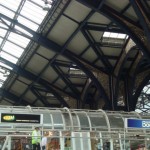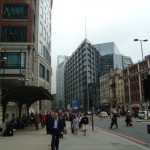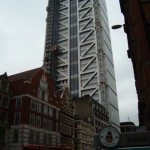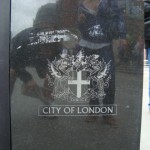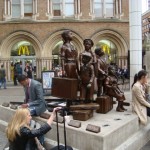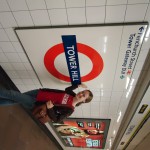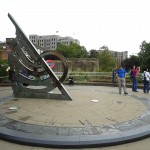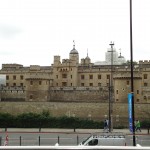August 26th, 2010 · 1 Comment
To get to Liverpool Street Station we took the Tube Circle Line from Euston Square Station directly to Liverpool Street Station. We arrived there about nineteen minutes after departure. We walked north from the Arran House Hotel on Gower to the end of the street where the Euston Square Tube Station was located. We briefly confronted some difficulties with figuring out how to use the Oyster Card, but quickly learned how to properly swipe the card. We found the Euston Square Tube station to be quite pleasant as classical music echoed off cement walls, and most other riders were quite reserved. The Liverpool Street Station, we learned, was named after the street upon which it lies, which in turn is named after the former British Prime Minister Lord Liverpool.
At Liverpool St. station, we surfaced to a very busy market full of food, clothing, and other types of stores within a beautifully designed old railway station. The architectural design of the station featured intricate steel beams supporting a glass, vaulted ceiling. The people within the station were a mix of those formally dressed in suits and dresses and those in more casual attire. People were either moving in a quite hurried manner or were impatiently waiting, giving off a vibe of stress. Outside, the station was surrounded by new and incredibly tall financial buildings, many of which were still under construction. However located nearby were also many stores, restaurants, pubs, and residencies subscribing to various architectural styles, though most were outdated. We suspect many people would travel to this area for the shopping, restaurants, and blossoming financial sector for their work, reflected in the diversity of garb. This station is located within the realm of the City of London. It serves as a important link to various other parts of England.
The monument located outside the Liverpool Street Station is a memorial to Jewish children escaping Nazi genocide via trains coming into London through this very station, once named the Great Eastern Railway. In 1938 and 1939 over 10,000 Jewish children escaped Nazi persecution with the help of English citizens. We also found a plaque located nearby dedicating the entire Hope Square to these children.
To return to the Arran House Hotel, we chose a different route on the Tube. We took the Central Line from Liverpool Street Station to Tottenham Court Road. We then took the Northern Line north to Warren Street Station. Upon exiting the Tube station, we then walked down Gower Street to the hotel.
Tags: 2010 ChristopherB · 2010 Mary
August 26th, 2010 · 1 Comment
-
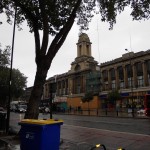
-
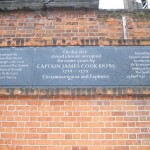
Getting to our stop, once we figured out our route, was a breeze. Jamie and I were eating sandwiches at a local café when we noticed that our stop was mere paces from our eat-bench. We descended into the depths of the tunnel, and Jamie effortlessly passed through the oyster machine. I, however, put my oyster card into the ticket slot and, to the dismay of both the man working the booth and the annoyed Brits behind me, brought the machine to a grinding halt. After being called a foreigner and having my ticket retrieved, we proceeded to our first train, the Northern route. In a paradoxical move, we took the Northern route south to the District route. We had to race up a few flights of stairs and were looking around frantically for the green District route sign when the train dramatically pulled up right in front of us, and took us to our destination.
Our station’s name is Stepney Green, and the reasoning behind the name is rather difficult to decipher. We gathered several bits of information that led us to a couple of theories about why the name is so. The borough name is Stepney, and the station is painted green which would lead to a rather obvious conclusion. We also found out that there is a park called Stepney Green nearby, which could have caused the station to be painted green, providing the station with a fitting and identical name to the park. To determine the true origin of the name will require more research and investigating than our soaking wet, sleep deprived bodies were able to muster.
As we bravely ventured into this so called, Stepney Green, we were bombarded with a crowd of people moving toward unknown destinations at an amazing speed. It made us feel like we were late for something; along with being the only two people completely unprepared for the 30 min long rain showers. After orienting ourselves we began to notice the people on the street and the store fronts along the street. Soon a trend began to form, we had arrived into a town that was predominately Muslim and Indian. The women pushing the strollers on the street were dressed in Burkas. Meanwhile, the shops along the street sold every type of spices necessary to create curries. The town was radically different of what Bloomsburry, where our temporary home the Arrand House is located, looks like.
The question remained as to where were we to find a monument in this maze of Indian store fronts. We walked for five blocks, stopping in store entrances when the rain was unbearable or to seek dosages of caffeine to keep us awake. At the end of five blocks in pouring rain, our stamina was dwindling, we were about to return to the tube when almost magically a monument appeared on the side of the building to our left hand side. The monument was dedicated to Captain James Cook Rivers, whom in 1759 surveyed the St. Lawrence River along with exploring the coasts of Australia New Zealand and the South Pacific in 1769. After making this discovery, we swiftly made our way back to the tube, only to have a close encounter with a bus while crossing the street.
Since it was requested to use an alternative route on our way back, we decided to take the Hammersmith & City( pink) to the Central route (red) getting off on the Tottenham and Court Road exit. After five flights of stairs we were on the street level only to realize all the buildings and stores were unknown. Some sympathetic UK citizens saw our faces of confusion and tiredness and pointed us to the right direction. Home was just two streets over and five blocks away!
Tags: 2010 Jamie · Uncategorized
August 26th, 2010 · 1 Comment
Upon leaving the Arran House Hotel, we decided to walk to the Tottenham Court Road Underground Station. This is likely the most efficient way to Notting Hill Gate, as we were able to take the Central Line directly to that station in less than fifteen minutes. The walk down Tottenham Court Road felt much like a normal, bustling, city street. Other than the presence of the Dominion Theatre right next to the Underground stop, nothing about the walk was distinctively “London.” However, once we entered the station we began to see much more of the cultural hodgepodge London society. A highlight was the sight of a couple making out on the train across from two women in burkas. The fact that such alarmingly different cultures could exist in the same car of the same train rang true with much of our summer reading about London.

Once we arrived at Notting Hill Gate, we found an abundance of ethnic restaurants lining the street. While we thought such different eateries would imply a diverse population, we found the exact opposite to be true. The area was filled with almost entirely white, apparently upper-class, by-passers. With a few dramatic exceptions, we found the area to be quite upscale, with immaculately designed townhomes and expensive restaurants and shops.

The station is named Notting Hill Gate because it is located on Notting Hill, which historically was the home to several toll gates. The station is here because of both commercial and residential appeal of Notting Hill Gate. People would travel to Notting Hill Gate because the area is almost a perfect living example of the hodgepodge of London’s cultural identity. The streets have a variety of ethnic restaurants – there’s a tapas bar next to a dim sum restaurant, which is across the street from a kabob restaurant – as well as a selection of oddities and clothing shops. There is no rhyme or reason to this area; Notting Hill Gate is a collection of interests from a variety of different cultures. There is also a residential aspect, which ranges from growing upper middle class town houses to large flat buildings for people living paycheck to pay check. It is in the Royal Borough of Kensington and Chelsea.

At our site we found a giant elephant statue. It was a large metal elephant that was more air than substance – it was made of thin wires that intersected each other in a flowy pattern with a fan where an eye would be. It was located outside of the Newcombe House on Notting Hill Gate. The elephant is one in a series all over London to raise awareness about the upcoming Elephant Parade Event, which raises money for elephants world-wide. The upcoming parade is not new but this is the first year it will be held in London. As far as we saw no one took notice  of the statue.
of the statue.
In an attempt to find out where the Notting Hill Carnival, an upcoming event, would be taking place, we decided to follow some signs that directed us to the point of the future festivities. Unfortunately, the signs quickly disappeared, and were (apparently) replaced with blue arrow signs attached to several poles up and down the street. As we began the trek down the roads where the signs were, we came across even more signs of affluence. There were gourmet shops, fishmarkets, and even a tailor shop packed with sewing machines. This was all quite fascinating, but at this point we had walked about 25 minutes and had not found the site of the carnival (so we thought). So we decided to make our way to the nearest Underground station. After some help from a woman on the street (Who introduced herself via weather-speak), and some more aimless wandering, we finally located the Ladbroke Grove Underground Station. At this point, we were exhausted. Luckily we were able to catch the Hammersmith & City line all the way back to the Euston Square Station, which was only a few blocks from the hotel. This trip took about half an hour, which combined with our forty minute hike through the streets of Notting Hill, was not quite as quick as our other route. Also, the train became packed at the Baker Street exit with mostly businessman making their way home. By the way, the carnival takes place on several of the streets of the Notting Hill area, so we did find it… a couple of times.
More information about the Notting Hill Carnival at: http://www.thenottinghillcarnival.com/
Tags: 2010 Amy · 2010 Andrew
August 26th, 2010 · 1 Comment
To get to St. Paul’s Station, we took the Tube from Goodge Street Station to the Tottenham Court Road Station, and then stayed on the central line for a few more stops until we arrived at St. Paul’s. It took us a little over ten minutes to get from the hotel to Saint Paul’s, including walking down 169 steps after we decided to skip the escalator. The Tube was very easy to navigate, although the map certainly came in handy. Holly, whose town has absolutely no public transportation, was impressed by how orderly everything was—people paid strict adherence to instructions to “mind the gap” and to keep right if they weren’t moving on the escalator, so as to let those in more of a hurry pass by.

St. Paul’s proved to be a very popular station, probably because it offers access to many London landmarks and museums, including St. Paul’s Cathedral, for which it is named. It is also within walking distance of the Tate Modern and St. Bartholomew’s Hospital, as well as several office buildings. Walking around the area around the station, we realized that St. Paul’s is a gateway to the City proper. 
Just beyond the station lies St. Paul’s Cathedral surrounded by beautiful old buildings that resembled a postcard image of London. We decided that the cathedral itself was the best monument to highlight, as it is such an iconic part of the London skyline and is a standing monument to Sir Christopher Wren’s work. 
The area outside of the cathedral was teeming with tourists, most of whom did not display much religious inclination. There were a number of people milling around inside of the cathedral, but very few were actually there to pray or worship, and they were secluded at the front of the church.
There were also several groups of tourists outside of the church, and we were surprised at how informally they treated the area. One tour guide even jumped onto a statue of John Wesley and put his arm around the statue while he talked to the group. In general, people seemed to be more intent on taking pictures than on listening to the tour guide or reading the plaques (of which there were very many) that explained the significance of St. Paul’s. History was emphasized, however, with all of the plaques in the area. There were several statues on the cathedral grounds that commemorated religious figures, including St. Paul’s cross, which was supposedly erected first in 1191. On the other side of the station, we found Christ Church Greyfriars, another Wren creation, which was partially destroyed. The ruins of the knave have since been turned into a garden. This section seemed more business-y than the area immediately around St. Paul’s Cathedral, however.
On the walk back from Saint Paul’s Cathedral, we chose to walk down Newgate Street, which soon turns into High Holborn. Along this stretch, Baroque style architecture, characterized by ornate marble carvings and columns predominated. 
Soon enough, we walked upon the Holborn circus, a tiny traffic circle with a statue in the middle,. Finding the subject of the statue was made difficult by the traffic moving quickly around it, however, we later found the statue to be of Prince Albert. As we moved toward New Oxford Street, the architecture tended to be more of the modernist variety, with the odd Victorian building, and Georgian style architecture becoming more predominant in Bloomsbury.
Tags: 2010 Holly · 2010 Tyler
August 26th, 2010 · 1 Comment
Our destination was the Tower Hll tube Station. Tower Hill is in the borough of the Tower Hamlets, toward the East End of the city. From the hotel, we walked to the Goodge Street Station, located on Tottenham Court Road, and took the black Northern Line to Embankment. From there we took the green District Line to Tower Hill. The tube was not like the subway system that New York City uses. It is cleaner and less noisy. The only people talking on the train were people obviously travelling together or children. Almost none of the riders seemed to be in a rush, but they moved at a consistent, comfortable pace. This first journey took us about 25 minutes.
When we walked above ground at the Tower Hill Station, there were many things that quickly grabbed our attention. Firstly, there was a gigantic sundial. It was a monument. Across the street from the sundial platform, we could see the Tower of London built by the Normans to protect the port of London. Today it houses many exhibits of British history, including the crown jewels. Also located at the Tower Hill station is a piece of the old Roman wall, which marked the original city boundary. On the other side of the sundial platform, there was a monument dedicated to the sailors who sacrificed their lives during World War II.
The sundial has a surprising, almost hidden, meaning. Around the base, where the dial’s shadow casts down, images of London’s history are portrayed. Events such as the founding of the Tower of London in 1066, Shakespeare’s arrival in the city, the Great Fire of 1666, and the Blitz are artistically represented. The sundial is in this location because of all the history that surrounds it. The old Roman wall, the Tower Bridge, and the Tower of London attracts tourists and the sundial is a guide through the different ages of the city. Though initially we did not recognize the images around the sundial’s base, and others seemed to not notice them, people took pictures with the big dial.
Most of the people in this location seemed to be tourists. They interacted with the monuments by taking pictures of them or with them. There was an ice cream vendor on the street that drew groups of parents and children. A sign explaining why scaffolding covered parts of the tower supports the notion that this location is a large tourist attraction. The rest of the people seemed to be people traveling home from work who paid no attention to the monuments.
We took an alternate route home. This time, we traveled from the Tower Hill Station to Monument, where we switched to the red Central Line to take us back to Tottenham Court Road. This journey took us significantly longer, almost 40 minutes. This may have been caused by the start of the evening rush home from work. We noticed a lot more passengers in business dress with briefcases on the journey home. These passengers did not talk much either, but it was clear that they took the same route home routinely every day: they seemed almost robotic. Also, it was a really long walk from when we got off on the platform at Monument to the platform where we could get on the Central Line. We went down two long steep escalators, and back up two long steep escalators. Finally, the Tottenham Court Road Station is farther from Gower Street and the Arran house than Goodge Street Station.
Tags: 2010 David · 2010 Kaitlin · Uncategorized
August 26th, 2010 · 1 Comment
We began our journey with a short walk to the Goodge Street tube station where we proceeded to stand in the station looking around confusedly. Eventually, an employee directed us to take the lift or stairs, “it didn’t matter”. We decided to take the stairs but it turned out to be eight flights in a striped Alice in Wonderland winding staircase. Upon reaching the bottom, we took the Northern Line to Embankment and transfered to the Circle Line to Victoria station, named after Queen Victoria.
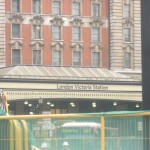
We noticed how clean the tube is, especially compared to the Subway in NYC. As we emerged onto the street, throngs of people hurried around us. Choosing first one direction, then the other, we began walking. Having no better ideas of what to do, when we saw a sign for Buckingham Palace, we headed that way.

We nearly passed the Palace, surprised by how small and under-whelming it is. Continuing to walk, we came to “Little Ben,” a smaller version of the famous London landmark, erected as a sign of Franco-British alliance.
We tried to express to each other exactly what the character of our assigned neighborhood was but found ourselves floundering. Some of the architecture seemed Victorian or even older but an equal amount of the buildings were done in a modernist style. The buildings held everything from restaurants to theatres, and we saw billboards for Wicked and Billie Elliot. The people were likewise a reflection of this confused, or at least blended, character. Walking the streets were people in all styles of clothing, tourists, and people of all races, and ages. It was easy to see why people came to Victoria, it is in the center of the city and has a variety of things to see and do.

By the time we’d walked around for a while, we were hungry and overwhelmed by the number of options and the pace of the people around the Victoria station. We had coffee and then returned to the Arran House, mission accomplished.
Tags: 2010 Daniel · 2010 Melissa · Uncategorized
Upon departure from our safe haven at the Arran House, we attempted to navigate the streets of London to no avail. While aimlessly wandering, we stumbled upon such landmarks as the British Museum and the University of London, essentially touring the greater London area for a thorough hour. After questioning a few pedestrians and going in the wrong direction on more than one occasion, eventually we made it to the Euston Square Tube Station. We boarded the train and set out for the Barbican stop located on the Metropolitan Line.
The name Barbican was chosen for the train station in 1968 as an alternative to the former name of “Aldersgate”, renamed for the famous Barbican Centre, the largest performing arts centre in all of Europe.
The general feeling of the Barbican area of London was a sophisticated, high class, multi faceted slice of society in which the arts and business thrive. We visited the Barbican Centre, a beautiful achievement in the arts (among them, surrealistic modern art, dance, music, and theater). We briefly viewed an exhibit that was on display courtesy of John Bock. In the back of the Centre was a great fountain display accompanied by hipsters and coffee shop-goers lined with elegant churchlike buildings from the days of old. When we made our way further towards the Business and Commercial area of Barbican, we found many towering, glass company buildings. Even further down the road we encountered many shops before we embarked on the journey home via the Tube.
On the way back we enjoyed a scrumptious local Italian-ish dinner at a restaurant near the Euston train station. After the meal, we hopped back on the train and took the Northern Line of the Tube from the Euston station to the Goodge St. station, and returned safely home to the Arran House (in the pouring rain).
Tags: 2010 Benjamin · 2010 Rachel
August 26th, 2010 · 1 Comment
Today for our tube exercise, we were sent in search of Marleybone, an area just south of Regents Park. We initially had trouble finding the Goodge Street tube station, because it is actually on Tottenham, near the intersection with Goodge. It took us about fifteen minutes total to locate the stop, which is easily withing walking distance. Emily found the entrances to the tube to be more maze-like than any US subways, but we were successful at navigating and switching lines once underground. We got off of the tube at Oxford Circus, which is named because of its proximity to an intersection with the same name. People probably travel to this stop mostly in their leasure time, and especially to shop. However, we later realized that we could have gotten closer to our destination by taking the rout to Great Portland Street instead.
[/caption]
<a href=”http://blogs.dickinson.edu/norwichhumanities/files/2010/08/blog-and-stuff-0281.jpg”><img src=”http://blogs.dickinson.edu/norwichhumanities/files/2010/08/blog-and-stuff-0281-225×300.jpg” alt=”” title=”blog and stuff 028″ width=”225″ height=”300″ /></a>
Much of the area was devoted to shopping and restaurants. We could tell that this was an expensive shopping district due to the foreign brand name boutiques, and diverse restaurants and cafes (mostly not fast food). These shops and restaurants were all on the bottom floors of buildings that fit an older architectural style, that followed a certain uniformity. We noticed that the area seemed populated with mostly young people, but also individuals and groups that were diverse, age-wise and ethnically. Most of these people there seemed to have time on their hands, since they did not seem to be in a rush. They seemed more likely to be there for the afternoon than for a short lunch break.
Plaque on a building, apparently dating back to 1863
<img src=”http://blogs.dickinson.edu/norwichhumanities/files/2010/08/blog-and-stuff-0261-225×300.jpg” alt=”” title=”blog and stuff 026″ width=”225″ height=”300″ />
On one main street in this Marleybone, an entire block was lined with buildings with inscriptions such as “The Institute of Physics,” and “The Institute of Architecture.” We were not sure whether these were currently in use as schools or parts of a university, but we did find evidence that schools have existed in this area for a long time. A plaque on a tall red brick building that did not match up exactly with those around it dedicated a school to the father of the woman who founded it in 1863. We would like to know more about the history in that area.
<a href=”http://blogs.dickinson.edu/norwichhumanities/files/2010/08/blog-and-stuff-017.jpg”><img src=”http://blogs.dickinson.edu/norwichhumanities/files/2010/08/blog-and-stuff-017-300×225.jpg” alt=”” title=”blog and stuff 017″ width=”300″ height=”225″ /></a>
Tags: 2010 Emily · 2010 Sean
August 26th, 2010 · 1 Comment
For our Tube exercise, we travelled to Walthamstow. It is relatively far east (think Salaam Brick Lane east).
We started our journey at the Goodge Station and took the Northern Line north to the Warren Street station where we changed lines and rode the Victoria Line all the way east to the Walthamstow Central Station.
On the Tube, as in Watching the English, most people just kept to themselves. A few people were conversing loudly, but this was not the norm. Most people were travelling by themselves and avoided eye contact.
We noticed that the number of people on the line thinned out as the train travelled east. This seemed to be a reflection upon the geographic location of the stop and its relation to the socioeconomic standing of that area of London.
The obvious reason that people would travel to this stop is its proximity to nearby train and bus stations as well as open-air markets and shopping centers.
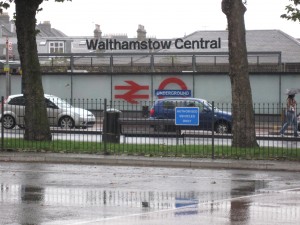
The area surrounding the station seemed to be primarily Afro-Caribbean and Middle Eastern. Many of the shops were targeted towards- and in fact, labelled for- these ethnicities.

Interactions between people on the street and in the mall were very lively and fast-paced. We observed (and heard) a vendor singing to advertise his goods and his patrons joined in. The fruits and banners in the market were brightly colored and visually stimulating, adding to the vibrancy and vividness of the scene.
Although there were no traditional monuments or plaques in the area, we came upon a library that was an interesting blend of modern and 18th – early 19th century design.

The architectural grandeur and elegance of its exterior served as a sort of centerpiece for the neighborhood.
In order to get back to Arran House, we took the Victoria Line from Walthamstow Central Station to the Finsbury Park Station. We then switched to the Picadilly Line and followed it to Holburn Station. From there we braved the rain and made our way (slowly) back to the hotel.
While on the underground on the way home, we had a fairly similar experience to that of the original trip. It was relatively uncrowded- we were able to sit all the way back- and people did not interact. A pair of men who had been talking loudly in the station continued their conversation on the train, much to the annoyance of a young mother sitting near them. She did not chastise them for their behavior but instead quietly looked away and rolled her eyes. This simple interaction seemed to us to be quintessentially British, at least based on Kate Fox’s observations.
Tags: 2010 Jessica · 2010 Patrick
Our adventure through London commenced with a magical trek from Arran House to Euston St. where we crossed the scariest intersection ever, and got onto the Underground at the Warren Street Station. We passed several colleges on the short walk there. Upon entering the Tube, we were nearly stampeded by what we assumed was a mass of English people fleeing Godzilla, but apparently it was just the normal speed people walk on the left side of the playbill decorated escalator (only the right side is for standing). On the approximately 10 minute ride, we noticed a lot of traditional religious dress, including Jewish men wearing yarmulkes and Muslim women wearing head scarves. This manner of dress was replaced in a dramatic way upon our exit from the station onto main street of Camden Town, part of the Borough of Camden in northwest London, by another form of culturally-influenced dress. The downtown area was filled with many aspects of thriving goth and punk sub-cultures. Tattoo parlors advertised themselves with what looked like controversial picket signs, reflecting a style rooted in subversive movements. Punk and alternative clothing outlets (some with plastic mannequin legs covered in ripped tights in place of awnings), independent record sales on corners, and many, many piercings filled every inch of the street (We received 4 piercing pamphlets within 5 minutes of arriving). Dreadlocks and mohawks ruled the day. This was very much in keeping with the spirit of Camden Town, though not in regards to its original namesake, the 1st Earl Camden, but rather by the integral part it played (and continues to play) in the development of the goth, punk, and underground music sub-cultures.
In addition to still being a gathering place for rebellious youth, Camden Town also features a huge variety of ethnic cuisine in fast food or market formats. The Camden Town Market appears to be an eccentric, large, and broad conglomeration of peoples and things from throughout the world. Throughout the Market, there were large bronze statues of lions in a Sphinx-like pose, an image that was repeated in all of the Market’s advertising. These figures’ effect on the population was amusing to behold as tough teens went over to pose with the statues, which represent the area that reflects their anti-conformist natures. Unfortunately, when we were preparing to take a picture of one of the monuments, we were caught in heavy rain which might have damaged the camera, and turned our return trip to the Arran House into a much less pleasant and enjoyable endeavor, as we had arranged our Tube departure to allow us to walk most of the way home, through Bloomsbury via Camden Town to Tottenham Court Road, where we changed direction and took Bloomsbury Street until it became our own Gower Street. On a brighter note, we did get to see some of those awesome Harry Potter-esque double decker buses.
Tags: 2010 Elizabeth · 2010 Jesse · 2010 MatthewM

